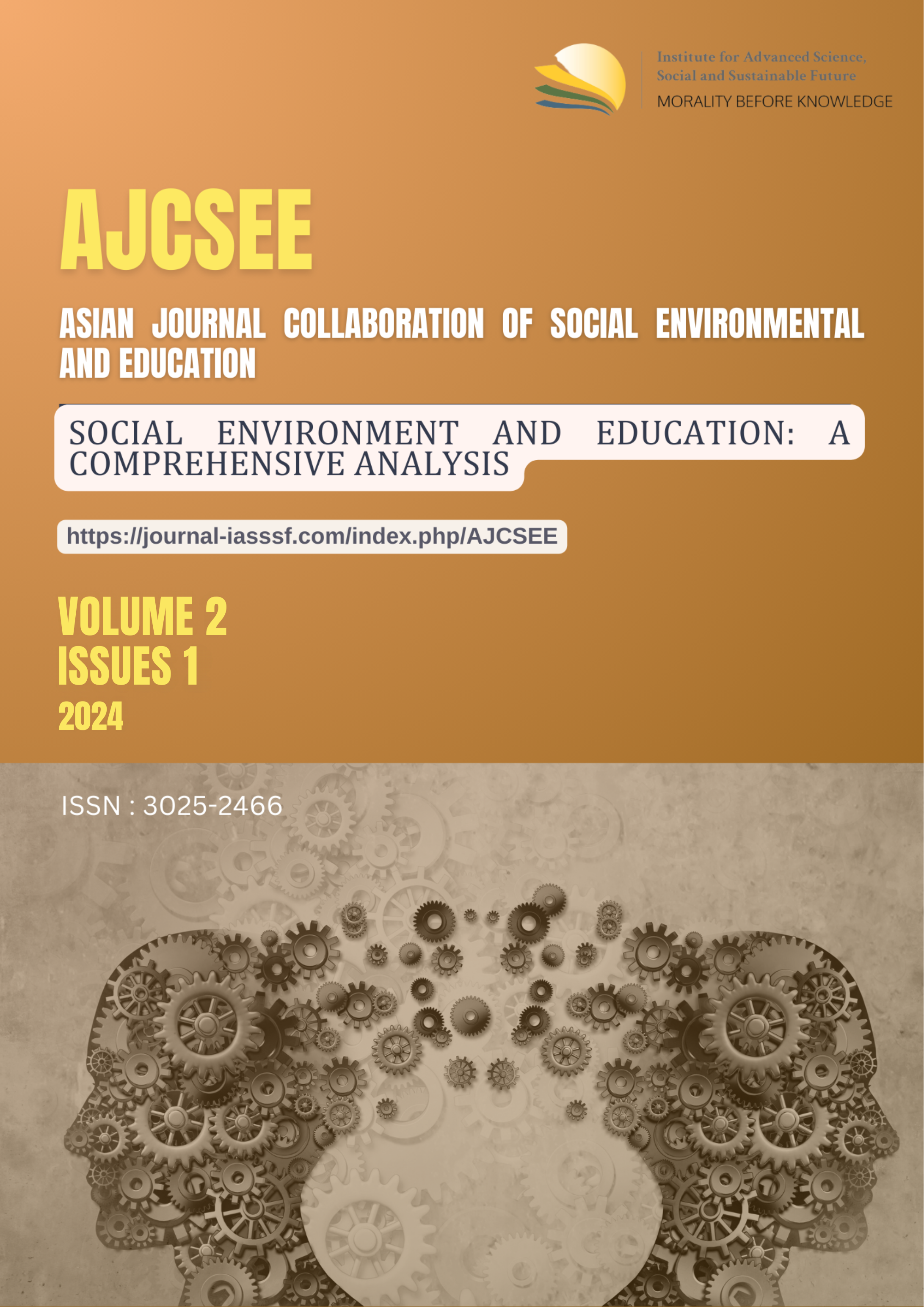Optimization of basic chemistry learning: Validation of STEM-based problem-based learning materials for chemical equilibrium
DOI:
https://doi.org/10.61511/ajcsee.v2i1.2024.909Keywords:
addie model, development of teaching materials, learning effectiveness, problem based learningAbstract
Background: The objective of this study is to create Basic Chemistry learning materials focused on the topic of Chemical Equilibrium using a Science, Technology, Engineering and Math (STEM) Problem-Based Learning approach. Effective learning is necessary to enhance students' understanding of complex chemistry concepts. Method: This study adopts the STEM Problem-Based Learning material development method, utilizing the ADDIE model, which consists of five steps: analysis, design, development, implementation, and evaluation. After the development process, the learning materials were assessed through an expert review stage. Evaluation was conducted to assess the validity of the design, pedagogical validity, and content validity using Aiken's coefficient as an indicator. Results: The expert review evaluation results showed high Aiken's coefficients: 0.98 for design validity, 0.95 for pedagogical validity, and 0.96 for content validity. These findings confirm that the developed learning materials comprehensively meet validity standards. Conclusion: Based on these evaluation results, it can be concluded that the developed Basic Chemistry learning materials, particularly on Chemical Equilibrium using the STEM Problem-Based Learning approach, meet the validity criteria. Therefore, these learning materials are considered suitable for use in the Basic Chemistry learning process. Novelty/Originality of this study: This study integrates the STEM Problem-Based Learning approach into developing Basic Chemistry learning materials, specifically on Chemical Equilibrium. Using the ADDIE model and comprehensive validation, this study presents a new framework for designing learning materials that simultaneously meet design, pedagogical, and content standards.
References
Abbott, A. (2016). Chemical Connections A Problem-Based Learning, STEM Experience. Science Scope, 39(7). https://doi.org/10.2505/4/ss16_039_07_33
Afriana, J., Permanasari, A., & Fitriani, A. (2016). Penerapan project based learning terintegrasi STEM untuk meningkatkan literasi sains siswa ditinjau dari gender. Jurnal inovasi pendidikan IPA, 2(2), 202-212. http://dx.doi.org/10.21831/jipi.v2i2.8561
Aiken, L. R. (1985). Three coefficients for analyzing the reliability and validity of ratings. Educational and psychological measurement, 45(1), 131-142. https://doi.org/10.1177/0013164485451012
Beers, S. (2011). 21st Century Skills: Preparing Students For Their Future. USA: ASCD. https://www.yinghuaacademy.org/wp-content/uploads/2014/10/21st_century_skills.pdf
Chen, Q. (2015). Research on teaching method based on deep learning theory. Shanghai Normal University: Master’s thesis.
Dahar, R. W. (2011). Teori-teori Belajar & Pembelajaran. Jakarta: Erlangga.
Daryanto & Karim, S. (2017). Pembelajaran abad 21. Yogyakarta: Gava Media.
Departemen Pendidikan Nasional. (2008). Panduan Pengembangan Bahan Ajar. Depdiknas: Jakarta.
Dolmans, D. H., De Grave, W., Wolfhagen, I. H., & Van Der Vleuten, C. P. (2005). Problem‐based learning: Future challenges for educational practice and research. Medical education, 39(7), 732-741. https://doi.org/10.1111/j.1365-2929.2005.02205.x
Estapa, A. T., & Tank, K. M. (2017). Supporting integrated STEM in the elementary classroom: a professional development approach centered on an engineering design challenge. International Journal of STEM Education, 4(6), 1-16. https://doi.org/10.1186/s40594-017-0058-3
Farwati, R., Permanasari, A., Firman, H., & Suhery, T. (2018, March). Integrasi problem based learning dalam STEM education berorientasi pada aktualisasi literasi lingkungan dan kreativitas. In Seminar Nasional Pendidikan IPA Tahun 2021 (Vol. 1, No. 1, pp. 198-206). https://conference.unsri.ac.id/index.php/semnasipa/article/view/688/305
Hanover Research. (2011). K-12 STEM Education Overview. Washington DC: Hanover Research.
Hapiziah, S., Suhery, T., & Mujamil, J. (2015). Pengembangan bahan ajar kimia materi laju reaksi berbasis stem problem-based learning kelas XI SMA Negeri 1 Indralaya Utara. Jurnal Penelitian Pendidikan Kimia: Kajian Hasil Peneltiian Pendidikan Kimia, 2(2), 206-19.
Haryani, S. (2014). Identifikasi Materi Kimia SMA Sulit Menurut Pandangan Guru dan Calon Guru Kimia. Seminar Kimia dan Pendidikan Kimia. Bandung: UPI.
Heriyana, E.S. (2013). Menggali Pemahaman Mahasiswa Kimia Angkatan Tahun Pertama FMIPA Universitas Negeri Malang Dalam Pokok Bahasan Elektrokimia Menggunakan Instrumen Diagnostik Two-Tier. Malang: Universitas Negeri Malang.
Irmita, L. U. (2018). Pengembangan Modul Pembelajaran Kimia Menggunakan Pendekatan Science, Technology, Engineering And Mathematic (STEM) Pada Materi Kesetimbangan Kimia. Orbital: Jurnal Pendidikan Kimia, 2(2), 26-36. https://doi.org/10.19109/ojpk.v2i2.2665
Jones, L. R., Gerald, W., & Victoria, A. S. (2015). TIMSS Science Framework 2015. US: Lynch School of Education Boston College.
Karim, N., & Normaya, N. (2015). Kemampuan berpikir kritis siswa dalam pembelajaran matematika dengan menggunakan model JUCAMA di sekolah menengah pertama. Jurnal pendidikan matematika, 3(1), 92-104. http://dx.doi.org/10.20527/edumat.v3i1.634
Kaymakci, S. (2012). A Review of Studies on Worksheets in Turkey. US-China Education Review A, 1, 57-64. http://files.eric.ed.gov/fulltext/ED530699.pdf
Kelley, T. R., & Knowles, J. G. (2016). A conceptual framework for integrated STEM education. International Journal of STEM education, 3, 1-11. https://doi.org/10.1186/s40594-016-0046-z
Khalidi, F. (2017). Sampoerna School System Menjawab Kelangkaan Tenaga Kerja IT.
Meyrick, K. M. (2011). How STEM education improves student learning. Meridian K-12 School Computer Technologies Journal, 14(1), 1-6.
Moore, T. J., Stohlmann, M. S., Wang, H. H., Tank, K. M., Glancy, A. W., & Roehrig, G. H. (2014). Implementation and integration of engineering in K-12 STEM education. In Engineering in pre-college settings: Synthesizing research, policy, and practices (pp. 35-60). Purdue University Press.
Munib, A., Budiyonto, & Suryana, S. (2015). Pengantar Ilmu Pendidikan (Edisi Revisi). Semarang: Pusat Pengembangan MKU/MKDK-LP3.
Prayekti. (2006). Penerapan Model Pembelajaran Interaktif pada Mata Pelajaran IPA di SD dengan Kerja Kelompok. Jurnal Pendidikan dan Kebudayaan, No. 059, Hal 285-302.
Rahmatina. (2020). Pengembangan Bahan Ajar Berbasis Science, Technology, Engineering, and Mathematics (STEM) di SMA/MA. Jurnal Phi: Jurnal Pendidikan Fisika dan Fisika Terapan (1)1, 27-33.
Reeve, E. M. (2013). Implementing science, technology, mathematics and engineering (STEM) education in Thailand and in ASEAN. Bangkok: The Institute for the Promotion of Teaching Science and Technology (IPST).
Sanders, M. (2009). STEM, STEM education, STEMmania. The Technology Teacher. 68(4), 20-26. http://hdl.handle.net/10919/51616
Sugiyono. (2018). Metode Penelitian Kuantitatif, Kualitatif dan R&D. Bandung: Alfabeta.
Sungkono. (2009). Pengembangan dan Pemanfaatan Bahan Ajar Modul dalam Proses Pembelajaran. Diakses pada tanggal 10 Februari 2022, dari https://journal.uny.ac.id/index/php/mip/article/view/6154
Torlakson, T. (2014). Innovate: A Blueprint For Science. Technology, Engineering and Mathematics in California Public Education. California State Superintendent of Public.
Yulianti, D., Wiyanto, Rusilowati, A., Nugroho, S. E., & Supradi, K. (2018). Problem Based Learning models based on science technology engineering and mathematics for developing student’s character. Journal of Physics: Conf. Series, 1170, 012032.
Downloads
Published
How to Cite
Issue
Section
Citation Check
License
Copyright (c) 2024 Asian Journal Collaboration of Social Environmental and Education

This work is licensed under a Creative Commons Attribution 4.0 International License.
















